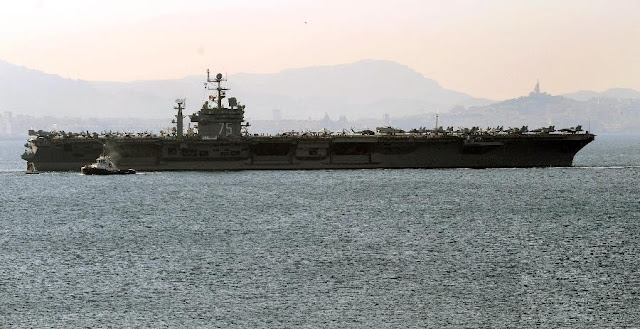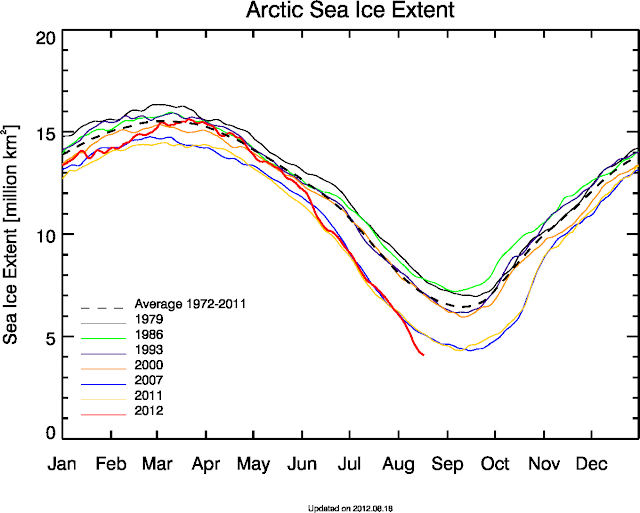By Veli Albert Kallio
 |
Veli Albert Kallio in front of Peter Wadhams and John Nissen at
APPCCG event, March 13, 2012, House of Commons, London |
I use three type sources to assess climate:
- the peer-reviewed literature and news reports;
- the whistle-blower organisations (Wikileaks, Cialeaks that release data files from the US Army, Navy, Air Force, CIA, the US State Department, or intercepted corporate telephone or Internet communications; and
- indigenous people’s organisations and their ethnoclimatology people.
June 26, 2012: the Cialeaks released data files from the US stating that the North Pole will be ice free in 2013. These appear to be submarine upward sonar readings of ice from the US Navy. These contrast strongly what NSIDC is saying about the sea ice surviving much longer. I do not know the reason why US Navy and NSIDC advice differently on this point (an exponential trend projection based on PIOMAS data gives zero-ice 2015).
As per the question, where all heat goes after the sea ice has melted, I stick to the advice given in the United Nations General Assembly motion 101292: the Polar Ice responds extremely fast: first the sea ice melts and disintegrates, then followed by intense methane surges and equally rapid losses of the Arctic terrestrial ice cover in Greenland which never melts, but collapses instead.
After the sea ice loss, the permafrost and Greenland Ice Sheet take up a large portion of that energy that was previously used to melt the sea ice during the short summers. As a result, the ocean warms up and rains much more water than now with the flash-floods becoming very frequent in Greenland. As a result many times more water appears on top of Greenland’s Ice Sheet.
Greenland Ice Sheet rapidly metamorphoses from a (cold, dry, stable) moraine-forming ice sheet into a (warm, wet, dynamic) aggregate-forming ice sheet as the water amount within ice sheet and at its base increase. The bottom part of the ice sheet turns increasingly into water-logged, “mushy” ice that loses its internal strength, while pot holes on bedrocks become filled by water.
By 2020's 1/3 of Greenland Ice Sheet's base (between ice and bedrock) is dotted with water ponds at which point the rapid erosion processes (cavitation, plucking and kolking) pulverise the ice so aggressively that an "ice sheet thrust" develops against coastal perimeter at Melville Bay area. Even the dry parts of ice sheet then no longer can hold the ice dome in place and Heindrich Ice Berg Calving Event (H-1) occurs.
After the Heindrich Minus One (H-1) event the North Atlantic Ocean between America and Europe fills by broken ice that triggers a near-instantaneous severe climate cooling: the Last Dryas. Europe will see many years lasting freeze with Dryas Octopetala rapidly taking hold across continent's then barren soils. The ice volume is 10 times less in Greenland than in a similar event when the Hudson Bay Ice Dome reminders collapsed.
This ice evolution history of the First Nations of Americas as expressed on the UN General Assembly motion 101292 and the Plantagon Declarations, were used on the global-warming themed film “A Day After Tomorrow” and also “2012” by director Roland Emmerlich. Unfortunately, the films assigned incorrect physics and caused great annoyance among the Native American Indian communities due to many other inaccuracies in details therein:
“2012” films ‘mystery radiation of sun’ was never caused by neutrinos, but methane: the Bøllinger Years. The ‘core melting’ was due to the displacement of asthenosphere’s fluids as the heavy Foxe-Laurentide Ice Dome destabilised forcing the liquid minerals in asthenosphere to move out of way, the pressures causing huge eruptions and lava floods (asthenosphere is like a “wet sponge”, a composite of solid and liquid minerals).
“A Day After Tomorrow’s freeze failed the Boyle’s Law: ultra-cold stratosphere cannot fall, and cause instantaneous sea level jump that was followed by the Younger Dryas freeze-up, but ice can.
The First Nations of Americas have raised the alarm very clearly continuously for the last 20 years since the first Rio de Janeiro summit in 1992 that the West is living in delusions (including its scientists). Just like the perimeter between the south tip of the Baffin Island and the north tip of Newfoundland once failed, ending the Ice Ages, the rapid melt water accumulation same way destroys now Greenland’s perimeter barrier at Melville Bay. Wet solidus damage causing lava floods and inlet fjord leaks can suddenly speed it up even more unpredictably.
Here is Professor Oren Lyon Jr.’s (Native American Tradition-Keeper and Historian of the Six Nations who worked at the University of Buffalo), the Internet summary of the Plantagon Declarations:
http://www.youtube.com/watch?v=4OjjPETcz6AThere is no point just to observe and repeat only points that appear in the professional literature. I want other communities’ perspectives and wisdom to be also realised and acknowledged:
+ either: the ancient experiences of the ancient people,
+ or: for the huge risks that people take to uncover often illegal practises by the corporations who are often acting in tacit co-operation with government officials, scientists or industrialists who are hostile to admit publically the role of greenhouse gases that violate their pet paradigm that the economic growth can be based on infinite growth from fossil-fuelled supply of goods and services.
Veli Albert Kallio, FRGS
International Guru Nanak Peace Prize Nominee for 2008;
sea level rise risk for global security & economic stability.








,+Sep+9,+2012.jpg)


,+August+27,+2012.png)




































